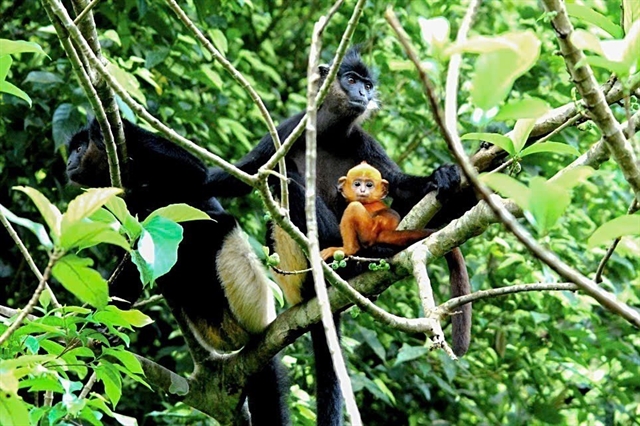 Environment
Environment

 |
| A mother and baby Delacour's langurs (Trachypithecus delacouri), a critically endangered species, in the semi-wild enclosure at Cúc Phương National Park. — VNA/VNS Photo |
HÀ NỘI — Interagency collaboration in biodiversity protection is being highlighted as a key solution to maintaining progress in sustainable and green economic development.
A flexible mechanism among law enforcement forces, state management agencies and social organisations is considered essential to continuing achievements in forest protection, nature conservation and ecological balance.
The Ministry of Agriculture and Environment (MAE) reports that Việt Nam currently has over 14.8 million hectares of forest, with a forest coverage rate of 42.03 per cent.
The country is home to 178 nature reserves, including 35 national parks that host thousands of endemic species. Việt Nam also ranks among the top 10 countries globally with the highest biodiversity.
However, significant challenges remain regarding ecosystems and forest resources, including deforestation, illegal logging, wildlife trafficking and habitat degradation. Violations are becoming increasingly sophisticated and organised, causing serious environmental damage and undermining Việt Nam’s international reputation in fulfilling global conservation commitments.
Managing, conserving and sustainably growing forest resources and biodiversity requires coordinated efforts from the entire political system. In this aspect, state agencies in charge of forestry and biodiversity alongside environmental police forces play a crucial role in coordinating law enforcement and combating crimes.
At an event in Hà Nội in early November, a coordination plan to combat biodiversity-related crimes and violations during the 2025-2030 period was signed between the MAE’s Việt Nam Forestry Administration and Nature and Biodiversity Conservation Agency, as well as the Ministry of Public Security’s Department for Environmental Crime Prevention and Control (C05).
The plan is based on the Prime Minister’s Decision 1623/QĐ-TTg on strengthening the prevention and control of biodiversity crimes by 2030 towards 2050. The goal is to enhance interagency coordination, improve legal frameworks and policies and strengthen enforcement capacity to manage, protect and sustainably develop natural resources.
Accordingly, over the next five years, the three agencies will jointly implement several measures, including reviewing and improving legal regulations on conservation and handling violations.
They will also direct environmental police and forest rangers to patrol, investigate and address illegal trade, transportation and captivity of endangered species while increasing training, technical support and monitoring capacity for tracking the origin of forest products and wildlife.
Public communication and legal education will be prioritised to raise community awareness and encourage the public to avoid consuming or using products derived from wildlife or illegally sourced from forests.
Trần Quang Bảo, director of the Việt Nam Forestry Administration, noted that this plan would be the beginning of comprehensive and robust cooperation among agencies in nature conservation.
Việt Nam’s nationwide forest protection system would work closely with police forces and other stakeholders to effectively execute the plan, he said.
The forestry sector planned to enhance the application of science and technology to build a synchronised database system on biodiversity, including forest inventories, wildlife monitoring and forest product traceability.
Sharing data among management agencies, enforcement forces and research institutes would improve transparency and enable timely responses in state management, Bảo added.
C05 director Colonel Thân Văn Hải said the plan ensured a clear division of responsibilities among agencies, aligned with the duties and functions of each sector.
“Violations must be detected and addressed promptly at the grassroots level, ensuring a balance of professionalism, legality and efficiency. All violations will be strictly dealt with, with no exceptions or exemptions,” he said.
A representative from the Nature and Biodiversity Conservation Agency highlighted that habitat loss, illegal exploitation and the impacts of climate change were driving many species to the brink of extinction. Collaboration between functional forces would therefore be crucial for protecting species, restoring habitats and ensuring ecological balance.
The plan also established a mechanism for semi-annual and annual evaluations to assess results and adjust activities to fit realities. Beyond the three primary agencies, participation from local authorities, businesses, social organisations and communities was expected to contribute to the sustainable implementation of the initiative.
Numerous community-based conservation models and forest management initiatives linked to local livelihoods had proven that when communities benefit from forests, they become the most effective forest protectors.
The 2025-2030 interagency coordination plan reflected not only the determination of state agencies but also a strong message of Việt Nam’s solidarity, initiative and responsibility in its journey toward a green and harmonious future with nature. — VNS




